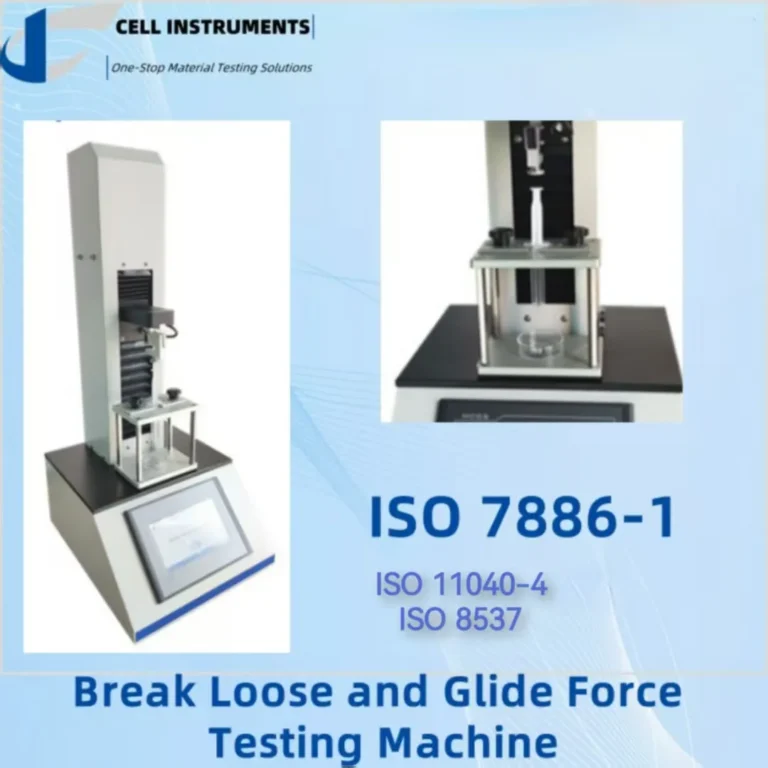Break Loose and Glide Force Testing: A Key Indicator of Syringe Performance
In the pharmaceutical and medical device industries, break loose and glide force testing is a critical procedure used to evaluate the usability and quality of syringes. These tests determine how much force is required to start (break loose) and continue (glide) the movement of the plunger within the syringe barrel. The results directly impact product compliance, injection comfort, and patient safety.
This testing method is especially vital for manufacturers developing prefilled syringes, sterile subassemblies, and auto-injector components. An overly tight or loose plunger can lead to dosing errors, plunger detachment, or inconsistent medication flow—all of which pose safety risks. For this reason, the testing process is clearly outlined in multiple international standards, including ISO 7886-1, ISO 11040-4, and ISO 8537.
Syringe Glide Force Testing and International Compliance Standards
Regulatory bodies have established strict requirements to ensure syringe performance is reliable and reproducible. Syringe glide force testing evaluates friction behavior under specified conditions, with the aim to detect variations in lubrication or material properties.
ISO 7886-1
This standard applies to single-use sterile syringes. It defines force measurement methods for both break loose and glide values, which must remain within pre-established ranges to guarantee smooth operation. The test speed typically used is 100 mm/min, and high-frequency data acquisition (≥500 Hz) is recommended.
ISO 11040-4
Focused on glass barrels for prefilled syringes, this standard includes Annex E, which specifies the glide force test method for sterile subassemblies. It outlines requirements for the plunger stopper, barrel interior, and silicone oil lubrication. Consistent low friction is essential to meet the criteria defined in this standard.
ISO 8537
Designed for insulin syringes, this standard emphasizes accurate dose delivery through control of plunger motion. Glide resistance is especially critical in insulin delivery devices, where a steady injection rate ensures safe glucose management.
Test Procedures and Parameters
The procedure for break loose and glide force testing follows a structured format:
Preparation
Use sterilized empty syringes ready for filling. Install a compatible plunger stopper with defined lubrication levels.Setup
Place the syringe in a universal testing machine or dedicated equipment such as the Cell Instruments SSR-01 Syringe Sliding Resistance Tester. Secure it with proper fixture alignment to ensure axial motion.Execution
Initiate plunger movement at 100 mm/min. The testing equipment records the break loose force (initial peak) and the glide force (mean force during continued movement).Data Capture
Record key data including:Break loose force (f₀)
Mean glide force (F)
Maximum glide force (Fₘₐₓ)
Travel distance and test duration
Evaluation
Results are compared against specification limits in ISO 7886-1, ISO 11040-4, or ISO 8537, depending on syringe type.
Common Issues Detected Through Glide Force Testing
Break loose and glide force testing uncovers critical syringe quality issues, such as:
Excessive friction from insufficient or uneven silicone coating
Sticking plungers, affecting dose accuracy
Material incompatibility between barrel and plunger
Plunger disconnection or seal leakage under axial force
Identifying these issues during R&D or production protects downstream processes and patient outcomes.
Recommended Equipment: Cell Instruments SSR-01 Syringe Sliding Resistance Tester
To execute these tests accurately and in compliance with ISO standards, Cell Instruments offers the SSR-01. This instrument is designed for:
Precise measurement of break loose and glide force
Adjustable test speeds and programmable test settings
Real-time data display via a 7-inch HMI touch screen
Built-in micro-printer for immediate reporting
Flexible fixtures for different syringe formats
Its intuitive interface and robust performance make it ideal for both quality assurance and product development labs.

Why This Testing Matters for Manufacturers
Supports regulatory filings with ISO-compliant data
Improves product usability by eliminating sticking or erratic flow
Increases batch uniformity for high-volume production
Reduces risk of recall due to mechanical failure
Enhances patient comfort, especially for auto-injector and insulin syringes
Conclusion
Break loose and glide force testing is a fundamental part of syringe quality evaluation. Adhering to ISO 7886-1, ISO 11040-4, and ISO 8537 ensures product reliability, regulatory compliance, and safe drug delivery. By investing in advanced instruments like the SSR-01 from Cell Instruments, manufacturers can confidently deliver high-performing syringes that meet both industry and patient expectations.